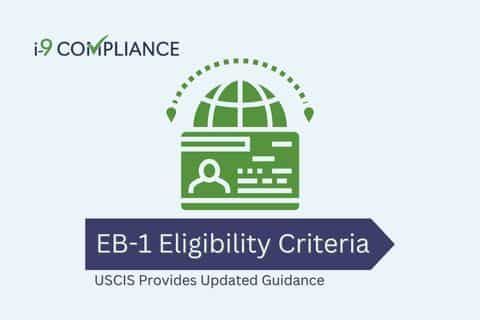USCIS Provides Updated Guidance for EB-1 Eligibility Criteria

October 3, 2023
The U.S. Citizenship and Immigration Services (USCIS) has provided new guidance regarding the EB-1 immigrant visa classification in its Policy Manual. This guidance is primarily for USCIS officers evaluating whether an individual meets the eligibility criteria for these visas. However, it may also prove helpful for employers and their chosen beneficiaries.
The employment-based, first-preference visa is crucial for employers hiring talented individuals in the United States. Many consider it a valuable workaround for individuals not selected by the electronic H-1B lottery. The EB-1 preference includes multiple occupational categories, including EB-1A and EB-1B.
EB-1A and 1B are for highly talented individuals. Examples include those with extraordinary ability in their field, which applies to EB-1A, and outstanding professors or researchers for EB-1B. These categories have received updated guidance from the USCIS.
The EB-1 immigrant visa classification remains unchanged under this new guidance. However, the policy manual now provides more guidance for USCIS officers, addressing how to interpret existing laws and regulations. This guidance also helps employers and their beneficiaries understand the rules. This clarification is crucial due to the often-confusing requirements for providing evidence proving eligibility.
Here are some of the most important updates USCIS made to Volume 6, Part F, Chapters 2 and 3 of the Policy Manual:
- This update includes examples clarifying what may satisfy these visas’ evidentiary requirements. It also explains what comparable evidence qualifies as substitutes to establish eligibility.
- USCIS also outlines additional considerations when evaluating submitted evidence, specifically focusing on the STEM (Science, Technology, Engineering, and Mathematics) fields.
- The new guidance provides examples of factors that would favor approving an application for an EB-1 visa.
These clarifications make it easier for officers to judge whether the submitted evidence meets at least three EB-1 requirements. It also informed the USCIS officers how to determine whether the evidence establishes that the beneficiary is at the top of their field. Furthermore, it also added transparency that allows employers and their beneficiaries to prepare their evidence.
This new guidance will alleviate some confusion surrounding the documentation USCIS requires. However, one documentation requirement many employers have and may continue to struggle with is the employment eligibility verification (Form I-9) process. The many challenging requirements for the I-9 process can leave HR personnel lost. However, an electronic I-9 management system offers step-by-step guidance, electronic storage, and many other features to help them remain compliant.
When it comes to your work, automation makes eligibility verification quick and seamless. Get a head start today with I-9 Compliance.